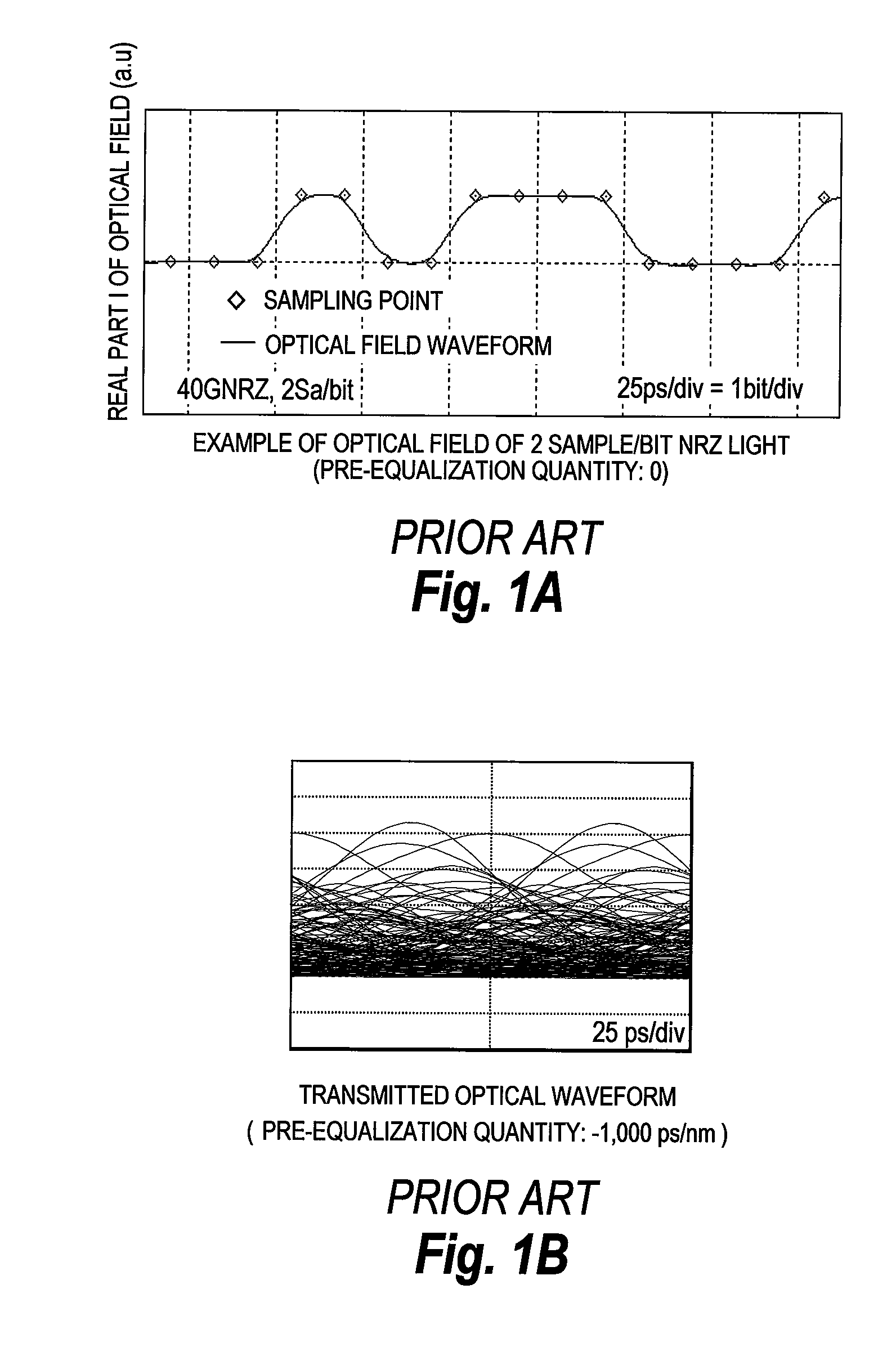Pre-equalized optical transmitter and pre-equalized optical transmission system
a technology of optical transmission system and pre-equalization, applied in the field of optical information transmission technology, can solve the problems of limited pre-equalization performance and difficulty in transmission, and achieve the effect of increasing the pre-equalization transmission performance and practicality
- Summary
- Abstract
- Description
- Claims
- Application Information
AI Technical Summary
Benefits of technology
Problems solved by technology
Method used
Image
Examples
first embodiment
[0062]FIG. 3 is a block diagram of a configuration of an optical transmission system according to a first embodiment of this invention.
[0063]Routes of digital signals are represented by thin lines, routes of high-speed analogue electric signals are represented by medium lines, and routes of optical signals are represented by thick lines. In an example described below, a binary information signal is converted into a ternary duo-binary signal to be transmitted. For the binary information signal, the bit rate and the symbol rate (baud rate) coincide with each other, and hence both of them have the same meaning in this case. However, as described later, this embodiment can be applied to a multi-valued information signal, and, in this case, transmission as 1 sample / symbol is necessary.
[0064]In the optical transmission system illustrated in FIG. 3, a 1 sample / bit pre-equalization optical duo-binary transmitter 100 inputs a non-modulated laser light output from a laser source 101 to an opt...
second embodiment
[0092]FIG. 6 is a configuration diagram of an optical transmission system according to a second embodiment of this invention, and a post-filter response equalizing filter 106 is added to the 1 sample / bit optical duo-binary pre-equalization transmitter 100 according to the first embodiment of this invention.
[0093]The post-filter response equalizing filter 106 is realized by a 1 sample / bit digital filter, and is a circuit for equalizing in advance an impulse response (time response) of the post filters 108-1 and 108-2.
[0094]FIGS. 7A and 7B illustrate optical waveforms showing an effect of the post-filter response equalizing filter 106, and an example illustrated in FIG. 7A is optical waveforms after pre-equalization transmission (pre-equalization rate: 100%) when the post-filter response equalizing filter 106 is not used. In the example illustrated in FIG. 7A, an 11-th order Butterworth filter −3 dB bandwidth of 0.4 Rb is used as the post filters 108-1 and 108-2. The post filters 108-...
third embodiment
[0112]In a third embodiment of this invention, by employing the optical interference effect in the digital signal processing, the chromatic dispersion tolerance of the generated 1 sample / bit optical duo-binary signal can increase to approximately four times that of the NRZ signal. As a result, even when a measurement of the chromatic dispersion of a transmission line includes an error, or when the chromatic dispersion changes, the pre-equalization transmission can be provided, thereby eliminating superfluous configurations such as a variable CD compensation circuit.
PUM
 Login to View More
Login to View More Abstract
Description
Claims
Application Information
 Login to View More
Login to View More - R&D
- Intellectual Property
- Life Sciences
- Materials
- Tech Scout
- Unparalleled Data Quality
- Higher Quality Content
- 60% Fewer Hallucinations
Browse by: Latest US Patents, China's latest patents, Technical Efficacy Thesaurus, Application Domain, Technology Topic, Popular Technical Reports.
© 2025 PatSnap. All rights reserved.Legal|Privacy policy|Modern Slavery Act Transparency Statement|Sitemap|About US| Contact US: help@patsnap.com



